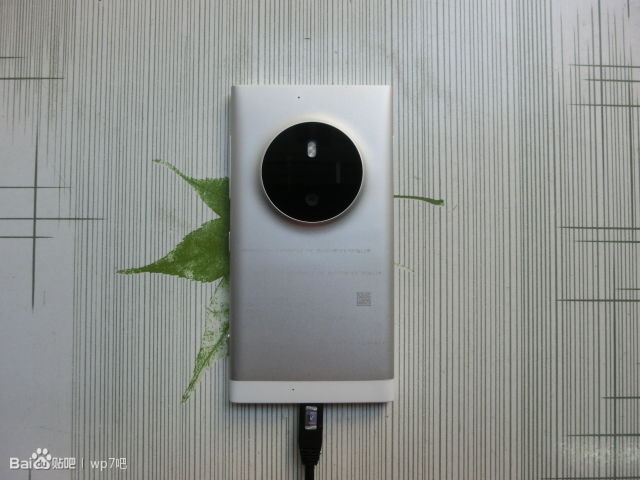Firstly, there are several rumours flying around. One was of a flagship with next-gen '3D' (as in air gestures and hand detection) interface option; another was of a 1030, a successor to the 1020 (obviously) and with similar high end imaging ambitions. Neither rumour had enough evidence to even make it worth mentioning here on AAWP.
Yet we now have images on Baidu (the Chinese equivalent of Facebook) from someone with access to a specific prototype that looks like it could have fitted either rumour (or both, obviously!)
The images first, and then my analysis.


From the scale of the photo, I'd say we're looking at a device with 5" AMOLED screen, reported as 1080p, and with virtual Windows Phone controls (Lumia 735 style). The bulk of the body seems to be aluminium, with radio aerials in the bottom plastic section and (probably) packed around the 1020-like camera island. The original photo set also includes an About page that shows 32GB of internal storage and 2GB of RAM, so specs overall are comparable with 2013's Windows Phone flagships.
Along with the tempting prospect that this might be a device that's about to be announced, there are some red herrings too - the OS version is quite a bit older than the version already being used around in the world for the Windows Phone 8.1 Update 1 Developer Preview. Plus there's mention of 'Nokia' in the About screen and on the back-of-device markings, in amongst plenty saying 'Microsoft Mobile' too, in fairness.
Both factors lead me to suspect that this prototype dates from the summer, i.e. three months ago, or so. It's not inconceivable that a device along these lines might be in development, for announcement at MWC 2015, but I'd either have expected other leaks by now or that the leak above would be more up to date.
Rafe and I have emphasised many times in the past that all companies build and test prototypes, sometimes many of them for every model that eventually gets to ship. Just because a proto exists doesn't mean that a product naturally follows.
The imaging side of things is interesting though - or at least the possible imaging side of things...
Blowing up and enhancing the first photo above gives us:

If this indeed a Lumia 1020 successor then it's worth noting that there's been a change in direction. For starters, the optics are showing (and I presume the leaker hadn't bothered to power up the camera Steve-style), in which case what we're looking at is a phone camera with electronic (i.e. not mechanical) shutter. It's hard to gauge the size of the camera from the images, but the height of the camera island looks similar to that on the 1020, lending credence to the rumour that the camera unit is at least as big, if not 'bigger' than that on the 1020, though I don't believe the '50MP' rumour.
What I think we're looking at in this prototype is a 1/1.5" sensor again, and probably at the same 41MP (implying that there's still PureView oversampling - or at least lossless zoom), but with an electronic shutter and latest-gen pulse dual LED flash (you'll remember that I covered the development of LED flash in my interview with ex-Nokian Damian Dinning recently).
Why would Nokia abandon Xenon flash, seemingly tied at the hip to imaging excellence on Nokia phones for years (and evangelised by me many times!)? The key is in the tie in with the latest trends in phone imaging, namely multi-shot computational photography. The latest iPhones and Android devices can shoot short bursts of images and then use their fast and powerful chipsets to do interesting things with them (picking out best shots, for example) and we're looking to Lumia Camera 5, due out imminently for Windows Phone, to do something similar on the top specced Lumia 930 and 1520, each with Snapdragon 800 processors. 'Rich Capture', "Dynamic Flash', and so on, and this is all clearly going to be part of whatever is next from the ex-Nokians at Microsoft.
All of which rather rules out Xenon flash. Xenon, you may remember, fires a bright but very short pulse (in the tens of microseconds) and the tie-in with mechanical shutters has traditionally been that you need to re-engineer the sensor to cope with the fast illumination - it's complicated but it's to do with the way the photo pixel charges are read.
However, even though the Lumia 1020 had a mechanical shutter, the fact that it also had OIS means that Nokia's (as they were at the time) engineers opted to try and let in ambient light as well as the reflected Xenon illumination, i.e. they deliberately left the mechanical shutter open longer. Begging the question - now that OIS is mature and in use in most mid-to-top-end Lumias, why have a mechanical shutter at all? And it's only a short step from there to take a look at multi-shot ambitions and the way Xenon couldn't be used satisfactorily to provide a light for each shot (there are recharge times and power requirements that get in the way), and then decide to go with LED flash instead.
It's true that the party piece of Xenon - freezing motion in low light - can't be replicated exactly, but the aim with a large enough sensor and powerful enough 'pulsed' dual LED flash is that a hypothetical Lumia 1030 (or whatever) could be used at a party (say) to take a multi-shot burst of snaps of someone, with each image oversampled (to reduce noise), each image captured at (say) 1/50s (quickish, to keep subject motion to a minumum), and with the flexibility to use Lumia Camera 5 to pick out the best/clearest photos from the burst later on.
It's true that achieving this would require a Snapdragon 800 series processor, ideally a 801 or 805, but it could be done - we already see Lumia Camera 5 pushing the oversampling processing into the background, perfect fodder for a core in a multi-core phone processor.
It remains to be seen how close I am in all this to whatever appears next year (if anything). Heck, we haven't even played with Lumia Camera 5 on the 930 and 1520 yet!

The Lumia 930, on which we'll be seeing Lumia Camera 5 imminently - at that point we'll have a good handle on what's possible with a Snapdragon 800 under the hood...
Is it possible that this prototype was never commissioned into a full product? Absolutely. In fact, it's downright probable. But the very existence of the prototype confirms the imaging path that Microsoft is 'on' - and for Xenon fans like myself it seems as though the 1020 may end up being the technology's last hurrah on Windows Phone. Is this a problem? Possibly not - if what I've outlined above can be achieved without Xenon then even I might be convinced!
